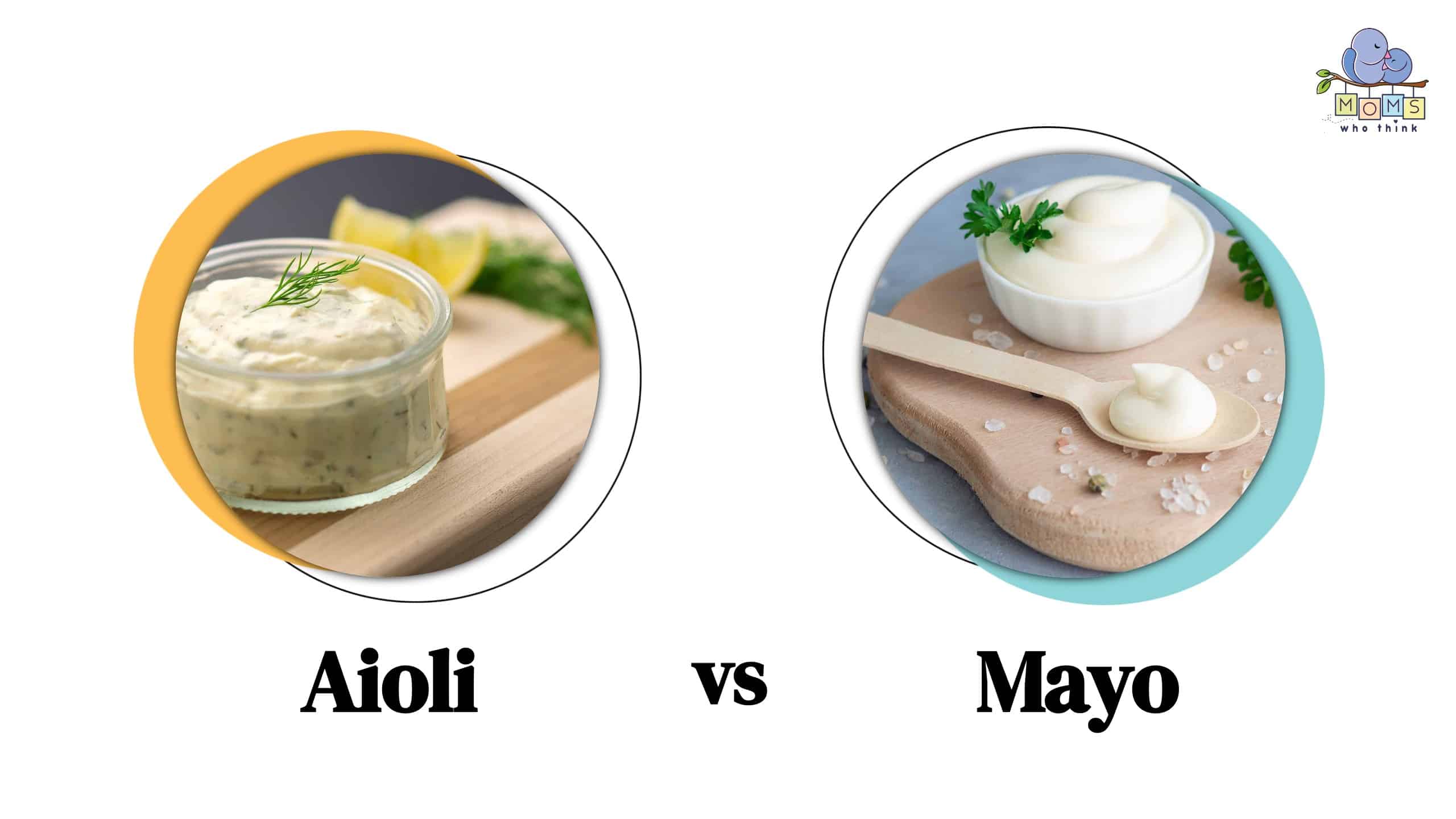You’d be forgiven for first thinking that there’s no difference between aioli vs. mayo since they’re both creamy emulsions. However, the main difference is how they’re made as aioli is made with garlic and olive oil, and mayo is made from canola oil and egg yolks.
Aioli vs. Mayo: What Is the Difference?
Mayonnaise and aioli both are creamy condiments. However, there are key differences between them. Traditional aioli has significant garlic content and uses extra virgin olive oil while mayo combines egg yolk with a flavorless oil (like canola oil) alongside vinegar or lemon juice. Aioli is common in many Mediterranean recipes while mayo originated in France. Their difference in ingredients also leads to varying flavors. Aioli has a stronger, more pungent flavor when compared to mayo.
It should be noted that there is no standard way to make aioli. It's traditionally made by emulsifying garlic and olive oil, but some recipes can use egg yolk as well.
Let's dive into more details on both condiments, including how they're made across the world and substitutes for each.
Aioli vs Mayo Nutrition: Calories, Fat, and Cholesterol in Each
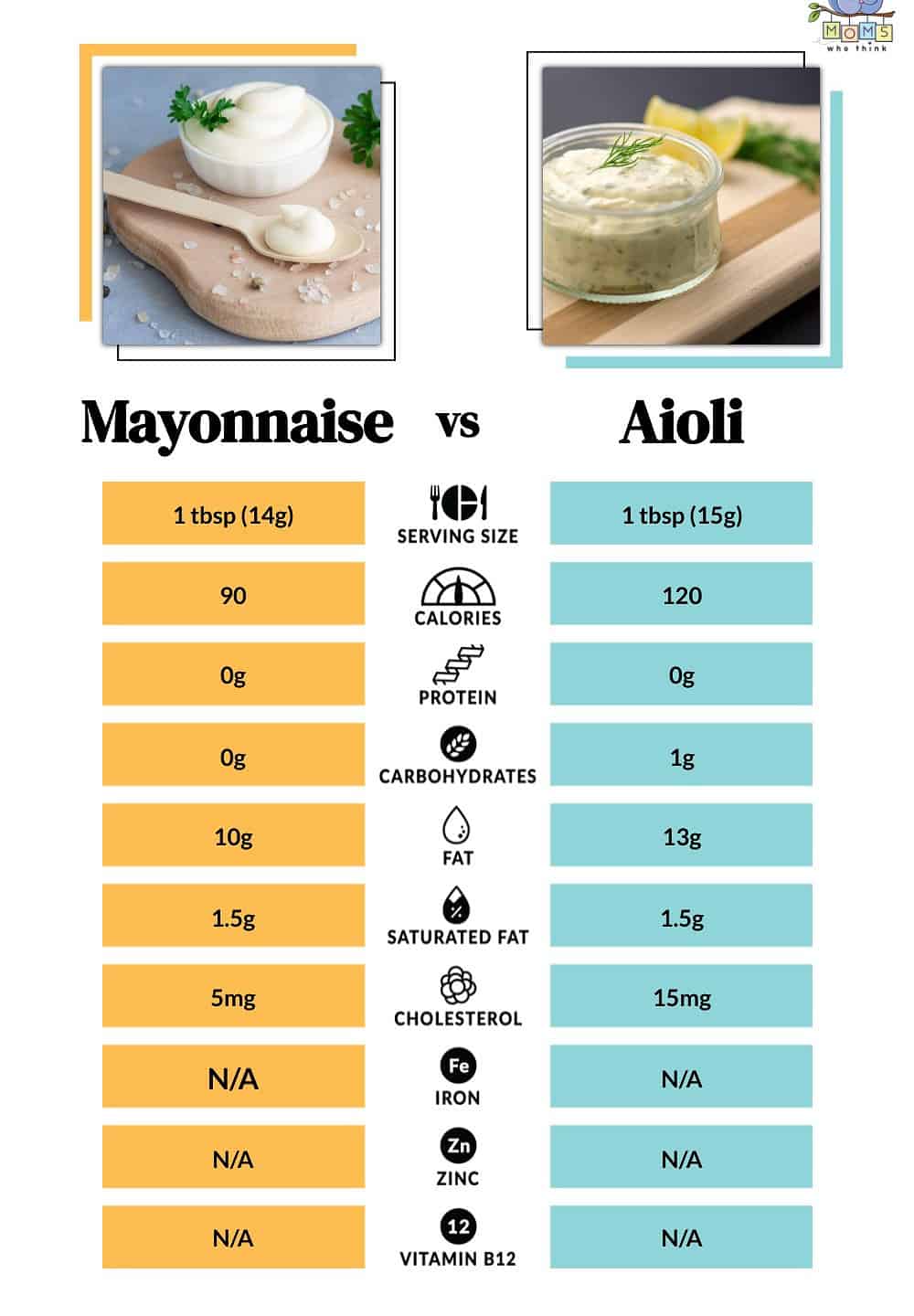
©
Mayo and aioli are comparable in most nutritional aspects. Both are heavy in calories per serving, depending on the brand both mayo and aioli are commonly around 100 calories per tablespoon and get their calories from fat macronutrients. However, it should be noted that depending on what brand you're buying (or the recipe you're following), the nutritional value of each condiment can vary dramatically. Recipes for low-calorie aioli and mayonnaise exist that will often swap out key ingredients like egg yolk for lower-calorie alternatives.
What Is Mayo?
Mayo or mayonnaise is a thick, creamy, and spreadable condiment that’s served cold. Mayo is typically used as either:
1. A supplement for sandwiches, hamburgers, french fries, potato salad, and composed salads.
2. A base for other sauces, such as fry sauce, tartar sauce, salsa golf, remoulade, and rouille.
It’s typically made by emulsifying canola oil, egg yolk, vinegar or lemon juice, mustard, and salt with a good whisk. People who try to avoid eggs can purchase or make eggless imitations.
History of Mayo
The first appearances of mayonnaise were around 1806 as a part of French cuisine. Some theories say it started with Spanish cuisine. There’s even a wild theory that mayo was born from when pharmacists used to emulsify egg yolk to prepare life-saving ointments.
The preparation of mayo has changed a lot over the years. Back in the early 1800s, it involved mixing aspic, allemande, oil, vinegar, salt, pepper, and parsley. These days, a product can only be called mayo if it contains eggs. So, products like Miracle Whip cannot be considered mayo and are instead considered to be salad dressing.
Uses of Mayo Around the World
Mayonnaise is used around the world in a variety of ways, often as a base for chilled sauces and salad dressings. Here is how it is used elsewhere:
Chile – This awesome country is the third largest consumer of mayo in the world. They typically use the ingredient as a topping on their completos.
Europe – Here, guidelines from Europe's Federation of the Condiment Sauce Industries state that in order to be called mayo, it must contain at least 5% liquid egg yolk and 70% oil. They use mayo on a variety of dishes in that area.
Japan – In Japan, mayo is typically made with rice vinegar, which gives it a very different flavor. It is also thicker than in the U.S. They use it on salads and specialty dishes like takoyaki, okonomiyaki, and yakisoba.
Russia – Mayo is incredibly popular in Russia. There, it’s typically made from soybean and sunflower oils. Mayo is so popular in Russia that it’s one of the only places where it sells more than ketchup. It’s typically used on salads.
United States – Mayo became popular in the U.S. back in 1907, when it was marketed in jars in Philadelphia. Back then, Mrs. Schlorer’s Mayonnaise was one of the most popular in town. Many other companies came after that, and currently, mayo sales come to over one billion dollars per year.
What is Aioli?
Aioli is often confused with mayo because of how the word “aioli” is often used in today’s context. If you go into many restaurants that serve flavored mayo, especially garlic mayo, they’ll often call it garlic aioli. They would like to serve a traditional aioli but it is a pretty labor-intensive process that they may not have the time to complete.
Aioli, which literally means “garlic oil” in Catalin, is made by emulsifying extra virgin oil with mashed garlic, usually with a pestle or mortar until it becomes a nice sauce. The sauce is sometimes served in America, but it’s especially popular in Spanish and French cooking.
How Aioli vs. Mayo Is Made
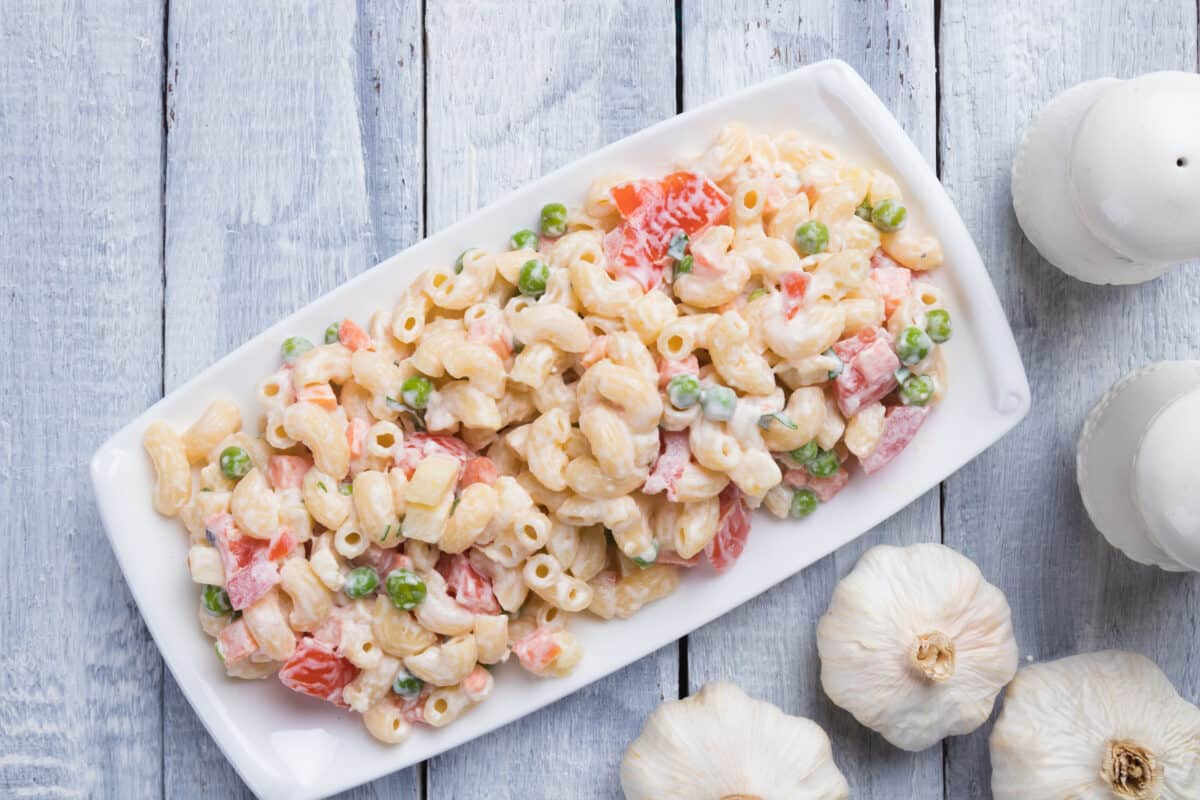
©Igor Dutina/Shutterstock.com
The difference between aioli vs. mayo can also be found in how they’re both prepared. When making mayonnaise, oil is whisked into egg yolks to start the emulsification process. As the ingredients start to come together, vinegar or lemon juice and salt are added into the mix. Then, the mixture needs to be mixed vigorously for all the ingredients to combine properly. Finally, as the oil droplets begin to become suspended in the egg yolk, it starts to create that fluffy texture. Once made, you can eat or serve. Homemade mayo will last about 3-4 days.
While aioli typically requires fewer ingredients, it can take longer due to the labor involved. Basically, several cloves are pounded into a fine paste using a mortar. While the chef continuously stirs and mashes the paste to emulsify the mixture, olive oil is slowly added. As the oil is continuously whipped, the oil particles break down and the mixture becomes creamy and blended. Some cooks add bread, egg yolks, and/or lemon juice to enhance the creaminess. In the end, the finished aioli sauce will be creamy and pale.
What Are Substitutes for Aioli?
If you like the idea of eating a tasty aioli, but you aren’t thrilled with the exact ingredients or consistency, then there are many aioli alternatives that you may consider. Among them are:
- Tartar sauce
- Thousand island dressing
- Tzatziki
- Skordalia
- Hummus
- Cream cheese
- Greek yogurt
- Avocado
What Are Substitutes for Mayo?
Many people like dishes that are made with mayo, but they don’t love the taste of mayo itself, and if that’s you, then you’re in luck. There are a number of mayo alternatives that you can add to your favorite dish. They include:
- Sour cream
- Pesto
- Greek yogurt
- Mustard
- Eggs (whipped)
- Miracle Whip
- Aquafaba
- Avocado
- Tahini
- Mustard
- Creamy salad dressing
There are many ingredients that are on both lists, like cream cheese, and that’s because they have a similar consistency to both aioli and mayo and can taste similar with the right seasonings. You can also make new concoctions that will fit the bill, like bean puree and cashew cheese.
Mayo Recipes
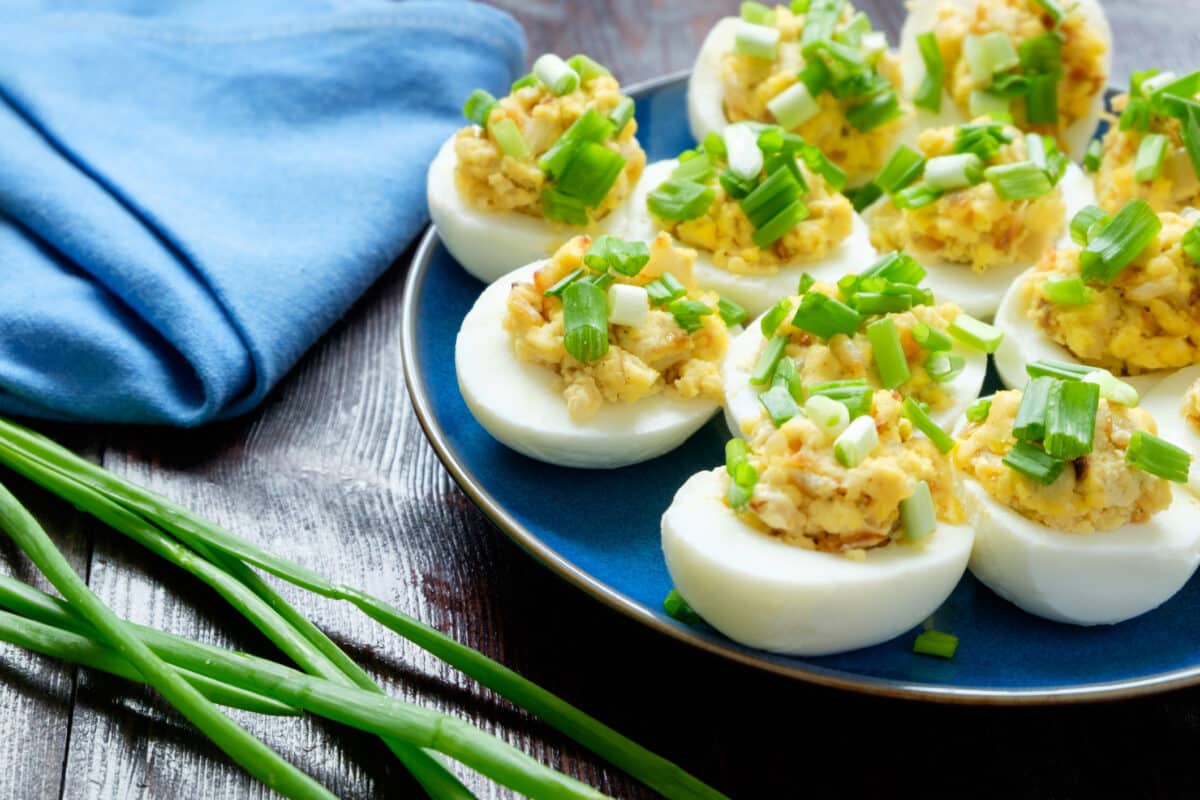
©iStock.com/Akiromaru
While you can dip food into mayo, it is typically used as an ingredient in many tasty foods. Some recipes you can make with mayo at home include:
Deviled Eggs – Add 1 1/2 to 2 1/2 tablespoons of mayonnaise for a perfect flavor pop that will keep them coming back for more.
Crab Stuffed Chicken Breasts – Add 2 tablespoons of reduced-fat mayonnaise, along with bread crumbs, parsley, and mustard to create a perfect topping.
Chicken and Broccoli Braid – Include ¼ cup reduced-fat mayonnaise with dill weed, yogurt, slivered almonds, and a few other ingredients to create this tasty chicken dish.
Buffalo Chicken Tenders – By adding mayonnaise, milk, and cayenne pepper to the chicken, you create this perfect finger food.
Breaded Turkey Rolls – 3 heaping tablespoons of reduced-fat mayonnaise plus breadcrumbs, mustard, paprika, and a dash of salt combine for the perfect turkey dish.

Deviled Eggs Recipe
Description
This is an easy to make and extremely tasty traditional deviled eggs recipe. The creamy yolk filling makes boring hard boiled eggs a wonderful appetizer.
Ingredients
- 6 Eggs
- Dash of Salt
- Dash of Pepper
- 1/4 Teaspoon of Mustard
- 1 1/2 to 2 1/2 Tablespoons of Mayonnaise
- Paprika
Instructions
- Hard boil eggs. Cool 10 minutes and remove shells.
- Cut into halves lengthwise and remove yolk, place yolk into a small bowl.
- Cream yolk, salt, pepper, mustard, and mayonnaise.
- Put 1/2 teaspoonful into egg whites and garnish with paprika.
Aioli Recipes
Aioli is a great dipping sauce for many tasty dishes, so you’ll often see it on the menu. One recipe that you must try is our corn fritters. When paired with a sweet aioli, it really makes the flavors pop.
You can also use aioli as a dipping sauce for a number of finger foods, including french fries, wings, and zucchini bites.
Conclusion
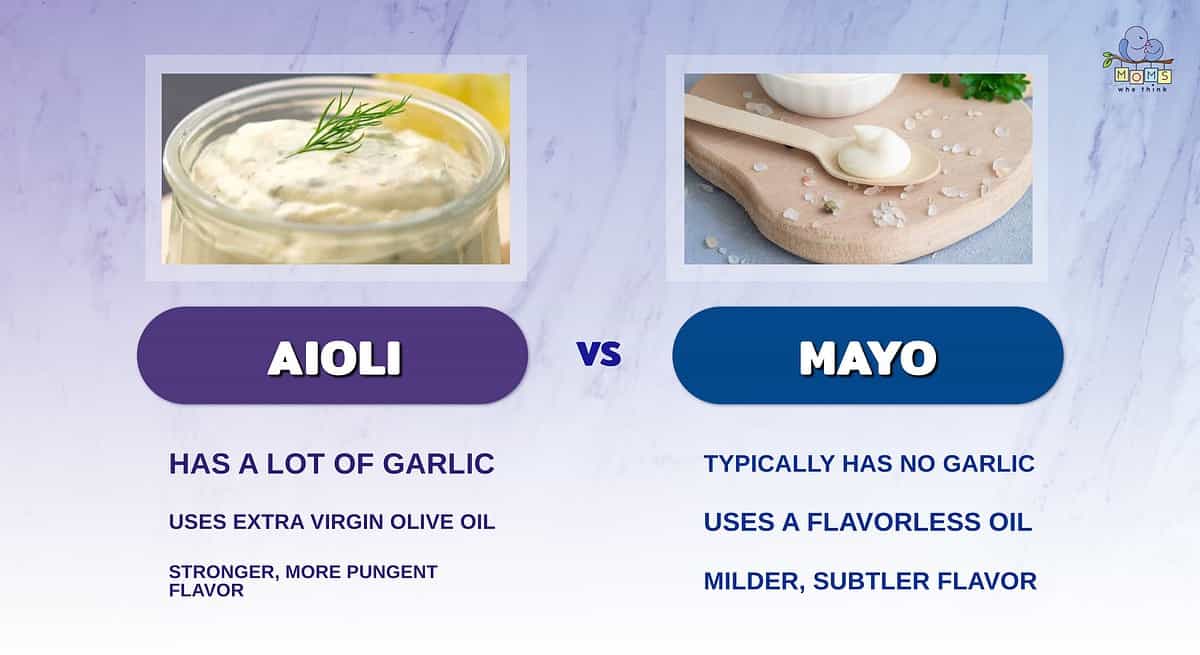
- Aioli uses a lot of garlic in its recipe, while mayo generally doesn't use any. You can find garlic mayo recipes online if you want to try your hand at it. The mayo you find in the store will generally not have garlic.
- Aioli uses extra virgin olive oil, which has a distinct taste to it. Contrarily, mayo uses a neutral, flavorless oil like canola oil.
- Because of the presence of garlic and extra virgin olive oil, aioli has a much stronger and more potent taste than mayo.
As you can see, though they are both sauces, there are a few differences between aioli and mayo. Use either in the correct application, and you’ll create a meal you won’t soon forget. Next time you see aioli on your favorite restaurant menu, don’t forget to ask if it’s the real deal!
